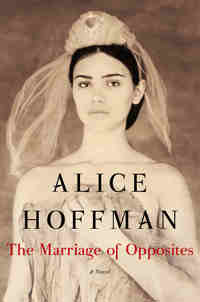
Published by Simon & Schuster on August 4, 2015
When writers choose to write fictional accounts of the lives of real people, the novel's success depends in part on whether they are writing about interesting people. I was more interested in the characters who appear in the second half of The Marriage of Opposites than those who appear in the first half, so I judged the novel as only a partial success. Although the most interesting character is the painter Camille Pissarro, we see very little of his artistic career in a novel that centers upon the lackluster life of Camille's mother.
In search of religious freedom, the Pomié family settled in St. Thomas in the late 1700s. Rachel Pomié begins her story in 1807. She grows up feeling oppressed by a mother who believes no purpose is served by her education. She longs for a civilized life in France, the country of her grandparents. Ten years later, as a dutiful daughter, she saves her family from financial ruin by consenting to an arranged marriage.
Rachel's childhood friend is Jestine, whose mother was a slave and who, like her mother, works as a maid. Jestine has a child, fathered by a lover who has been more-or-less adopted by Rachel's parents. The novel eventually turns into an extended family history that traces the lives of Rachel, Jestine and her illegitimate daughter, and Jacobo, one of Rachel's many children. Jacobo later adopts his middle name, Camille, while attending school in France.
Rachel has the qualities a modern author values in women -- emotional strength, intelligence, independence, courage -- making her seem a bit like the archetype of a modern woman who has been transplanted into early nineteenth century soil. Rachel's mother chastises Rachel for failing to accept that she is "a woman and nothing more," a fairly obvious device that Alice Hoffman uses to inspire sympathy for Rachel in her twenty-first century readers. Rachel is also kind, unprejudiced, passionate, level-headed, a loving mother to her children and step-children, a friend to servants, an opponent of slavery -- all admirable qualities that make her a little too perfect (at least until the end, when she begins to demonstrate some of her mother's inflexibility).
Rachel is headstrong and willing to defy convention in the name of love, which makes her a stereotypical romance novel heroine. She becomes something of an outcast, particularly among the gossipy members of her religious community. To the extent that The Marriage of Opposites is about the conflict between a community's judgment of a woman's moral values and a good woman's desire to follow her heart, it is an old story. Absent a fresh approach that is lacking here, the story just isn't very interesting. Adding a ghost (who is probably in Rachel's head) and a wise old herbalist simply accented Hoffman's use of literary devices that have been used many times before.
The first part of the novel, detailing Rachel's first and second marriages, cover familiar ground. Thanks to well-polished prose, events whiz along, but I was more taken by the descriptions of life in St. Thomas than by the various dramas with which Rachel must contend. At the novel's midway point, the story shifts to Jacobo, an artistic lad with the soul of a peacemaker. The novel later shifts to Paris, where Jestine's daughter lives and where Jacobo (now Camille) is trying to be an artist. All of this is easy to read but none of it grabbed me.
There is nevertheless much about the novel to admire, in addition to its faultless prose. The Marriage of Opposites illustrates how patterns learned early in life tend to shape us even when we despise those patterns. Rachel, for instance, cannot abide her mother's meddling in her life and resents all that she has been forbidden from doing, yet as she ages, she imposes her own prejudices upon Camille. Much of the story is about confronting the past, discovering roots, and coming to terms with heritage or family. To a lesser extent, it is about the destructive insularity of only befriending or doing business with members of the same race or religion. Those are worthy themes but they are not wrapped within a compelling story.
Love stories are scattered throughout the novel, providing occasional dramatic peaks, generally advancing the theme that love overcomes differences of class and race and (perhaps) religion, although characters tend to have more difficulty overcoming religious prejudices than others. Camille's struggle with romance might be the most interesting but it is relegated to only a few pages toward the novel's end. Other ordinary dramas of life -- births out of wedlock, snubs, spats, jealousies -- round out the story without contributing much in the way of energy. While the novel, like Rachel, sort of fizzles out in the end, there is enough to admire in this fairly dull story to earn it a guarded recommendation.
RECOMMENDED